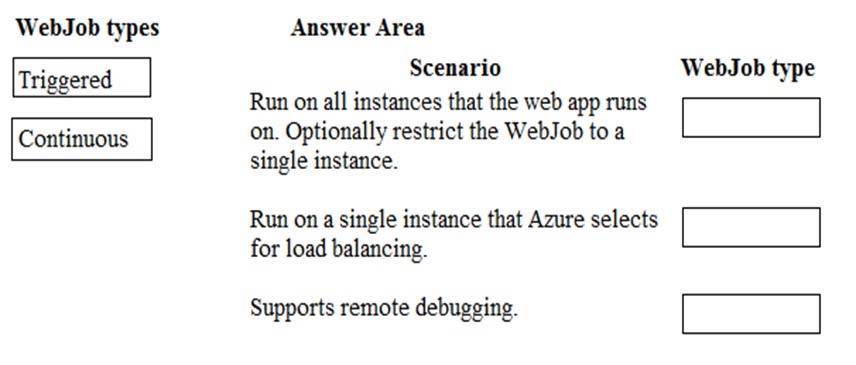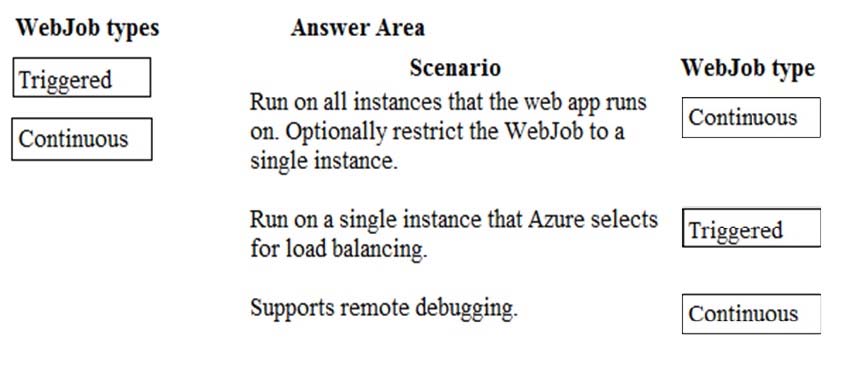

You are developing a solution for a company that hosts a large collection of videos in Azure.
Videos with celebrity speakers must be prioritized and featured on an Azure website. The videos must support closed captioning.
You need to select the Azure service that fits the requirements.
Which service should you use?
Correct Answer:
D
🗳️
Azure Video Indexer is a cloud application built on Azure Media Analytics, Azure Search, Cognitive Services (such as the Face API, Microsoft Translator, the
Computer Vision API, and Custom Speech Service). It enables you to extract the insights from your videos using Video Indexer models described below:
✑ Closed captioning: Creates closed captioning in three formats: VTT, TTML, SRT.
✑ Celebrity identification: Video Indexer automatically identifies over 1 million celebrities "" such as world leaders, actors and actresses, athletes, researchers, business and tech leaders across the globe. The data about these celebrities can also be found on various famous websites, for example, IMDB and
Wikipedia.
References:
https://docs.microsoft.com/en-us/azure/media-services/video-indexer/video-indexer-overview
DRAG DROP -
You are developing Azure WebJobs.
You need to recommend a WebJob type for each scenario.
Which WebJob type should you recommend? To answer, drag the appropriate WebJob types to the correct scenarios. Each WebJob type may be used once, more than once, or not at all. You may need to drag the split bar between panes or scroll to view content.
NOTE: Each correct selection is worth one point.
Select and Place:
Correct Answer:

Box 1: Continuous -
Continuous runs on all instances that the web app runs on. You can optionally restrict the WebJob to a single instance.
Box 2: Triggered -
Triggered runs on a single instance that Azure selects for load balancing.
Box 3: Continuous -
Continuous supports remote debugging.
Note:
The following table describes the differences between continuous and triggered WebJobs.
References:
https://docs.microsoft.com/en-us/azure/app-service/web-sites-create-web-jobs
DRAG DROP -
You manage several existing Logic Apps.
You need to change definitions, add new logic, and optimize these apps on a regular basis.
What should you use?
To answer, drag the appropriate tools to the correct functionalities. Each tool may be used once, more than once, or not at all. You may need to drag the split bar between panes or scroll to view content.
NOTE: Each correct selection is worth one point.
Select and Place:
Correct Answer:

Box 1: Enterprise Integration Pack
After you create an integration account that has partners and agreements, you are ready to create a business to business (B2B) workflow for your logic app with the Enterprise Integration Pack.
Box 2: Code View Editor -
To work with logic app definitions in JSON, open the Code View editor when working in the Azure portal or in Visual Studio, or copy the definition into any editor that you want.
Box 3: Logical Apps Designer -
You can build your logic apps visually with the Logic Apps Designer, which is available in the Azure portal through your browser and in Visual Studio.
References:
https://docs.microsoft.com/en-us/azure/logic-apps/logic-apps-enterprise-integration-b2b https://docs.microsoft.com/en-us/azure/logic-apps/logic-apps-author-definitions https://docs.microsoft.com/en-us/azure/logic-apps/logic-apps-overview
DRAG DROP -
You are developing a solution for a hospital to support the following use cases:
✑ The most recent patient status details must be retrieved even if multiple users in different locations have updates the patient record.
✑ Patient health monitoring data retrieved must be the current version or the prior version.
✑ After a patient is discharged and all charges have been assessed, the patient billing record contains the final charges.
You provision a Cosmos DB NoSQL database and set the default consistency level for the database account to Strong. You set the value for Indexing Mode to
Consistent.
You must minimize latency and any impact to the availability of the solution. You must override the default consistency level at the query level to meet the required consistency guarantees for the scenarios.
You need to configure the consistency levels to support each scenario.
Which consistency levels should you implement? To answer, drag the appropriate consistency levels to the correct requirements. Each consistency level may be used once, more than once, or not at all. You may need to drag the split bar between panes or scroll to view content.
NOTE: Each correct selection is worth one point.
Select and Place:
Correct Answer:

Box 1: Strong -
Strong: Strong consistency offers a linearizability guarantee. The reads are guaranteed to return the most recent committed version of an item. A client never sees an uncommitted or partial write. Users are always guaranteed to read the latest committed write.
Box 2: Bounded staleness -
Bounded staleness: The reads are guaranteed to honor the consistent-prefix guarantee. The reads might lag behind writes by at most "K" versions (that is
"updates") of an item or by "t" time interval. When you choose bounded staleness, the "staleness" can be configured in two ways:
The number of versions (K) of the item
The time interval (t) by which the reads might lag behind the writes
Box 3: Eventual -
Eventual: There's no ordering guarantee for reads. In the absence of any further writes, the replicas eventually converge.
Incorrect:
Consistent prefix: Updates that are returned contain some prefix of all the updates, with no gaps. Consistent prefix guarantees that reads never see out-of-order writes.
References:
https://docs.microsoft.com/en-us/azure/cosmos-db/consistency-levels